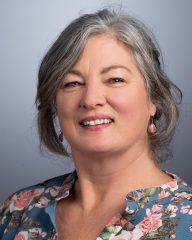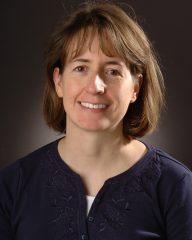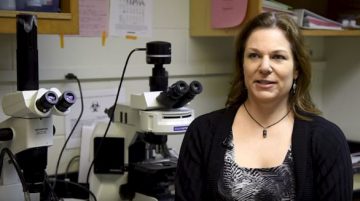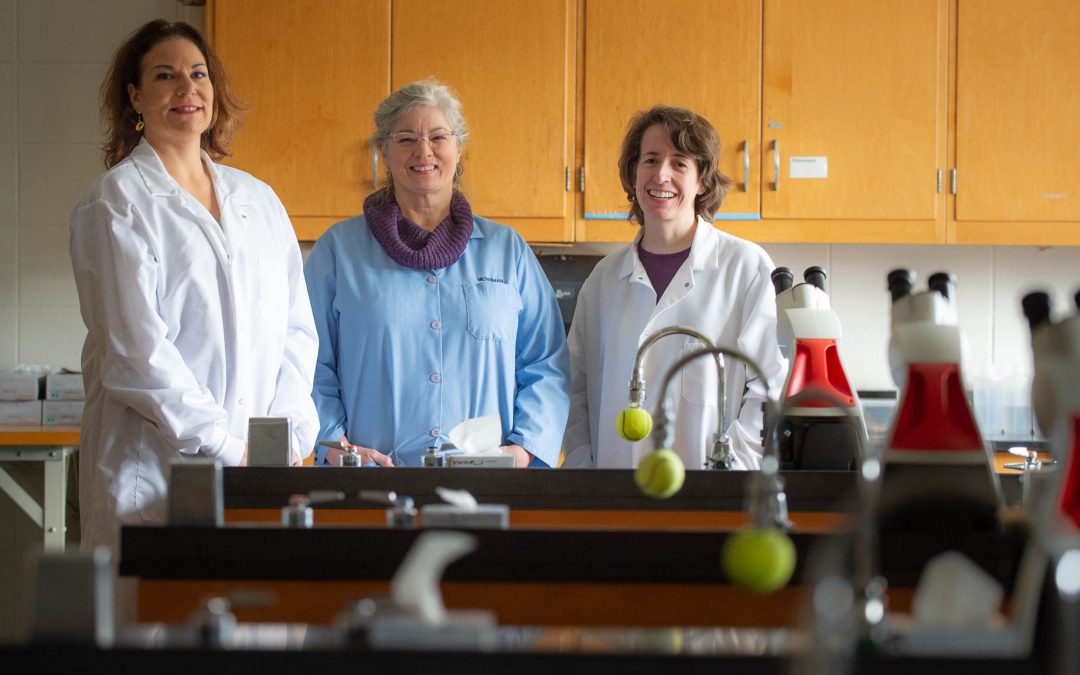It’s not every day you get to work on a bold or daring new project with scientists from across the nation.
University of Wisconsin Oshkosh neurophysiologist Dana Merriman is part of a team of researchers working to accelerate the development of regenerative treatments for blindness.

The team is one of five recently awarded Audacious Goals Initiative for Regenerative Medicine funding from the National Eye Institute (NEI), a division of the National Institutes of Health (NIH). The five-year award totals nearly $7.4 million, with $351,000 allotted to Merriman’s work at UWO.
Two of Merriman’s colleagues in the UWO biology department—gut immunologist Courtney Kurtz and parasitologist Michelle “Shelly” Michalski—also are working on NIH-grant-funded projects that have implications for improving human health across the globe.
“This is the first time that UW Oshkosh has had three consecutive projects funded by the NIH by three different researchers, all in the biology department,” said Kim Langolf, UWO Office of Sponsored Programs interim director. “The outstanding commitment by our faculty and administration is demonstrated by an elevated level of research at UW Oshkosh, which engages our students to gain real-world experience in state-of-the-art research labs.”
Colleen McDermott, dean of the College of Letters and Science, said the three researchers are all outstanding teachers, mentors and role models.
“The Department of Biology has won many awards celebrating the faculty’s ability to teach and to conduct important research in the biological sciences. These three biology faculty members—Drs. Courtney Kurtz, Dana Merriman and Shelly Michalski—exemplify how our mission to provide a liberal arts education can combine with high-quality research outcomes,” McDermott said.
“Each of the three researchers collaborate with a variety of other scientists on campus, across the state and, most importantly, with UWO undergraduate and graduate students, to find answers to critical questions related to the healthcare sciences. The fact that each has been awarded a prestigious NIH grant in the same time period is a remarkable feat, an amazing opportunity for our students and a great achievement for our campus.”
Restoring eyesight
Since 1998, critical research in Merriman’s visual system research lab has been funded by the WiSys Technology Foundation, the National Science Foundation and the Foundation Fighting Blindness as well as the NIH. Her role as director of the UWO’s 13-lined ground squirrel colony, which she began in 2008, has led to a number of research articles, including one in the May 3, 2018, issue of the prestigious journal Cell.
For the new Audacious Goals grant, Merriman is working with Joseph Carroll and Aron Geurts, of the Medical College of Wisconsin in Milwaukee; and Jacque Duncan, of the University of California San Francisco, to develop the squirrel as s cone-dominated retinal disease models. The goal is to use molecular and chemical tools to generate cone diseases that mimic those seen in humans and to evaluate stem cell-based treatments that will cure them.
She said their work may one day have implications for treating the genetic disorder known as Usher Syndrome, which total vision as early as preschool.
“Models that recapitulate human disease are essential to predicting the success of new therapies in humans,” NEI Director Paul Sieving said. “These audacious projects will be pivotal in our efforts to translate the latest science advances into new treatments for vision loss and blindness.”
Understanding obesity
Developing ground squirrels as a model also is key to Kurtz’s NIH research that has implications for the treatment of metabolic syndrome and obesity in humans—a worldwide epidemic.
 Kurtz is collaborating with Khrystyne Duddleston, of the University of Alaska Anchorage, on a $407,500, five-year federal grant from the NIH National Institute of General Medical Sciences. UWO’s portion of the award totals nearly $192,500 over three years.
Kurtz is collaborating with Khrystyne Duddleston, of the University of Alaska Anchorage, on a $407,500, five-year federal grant from the NIH National Institute of General Medical Sciences. UWO’s portion of the award totals nearly $192,500 over three years.
“This project uses a unique model—ground squirrels fattening prior to hibernation—to examine the role of gut microbes and the immune system in the accumulation of fat,” Kurtz explained.
Prio to hibernation, the squirrels undergo microbiota and immune changes as they build up fat for their long winter fast. These changes are similar to what happens when humans eat a high-fat diet as fat tissues grow and insulin resistance develops.
Kurtz’s research involves studying whether altering these parameters can affect the rate and degree of fattening in the squirrels.
“We’re looking to see if we can curb the weight gain in the squirrels as they get ready to hibernate, because they are a good model for humans,” she said. “We share a lot of genes with hibernators.”
Tackling tropical disease
While Merriman and Kurtz’s research programs both involve working with 13-lined ground squirrels, Michalski’s lab is concerned with the study of parasites and mosquitoes.
 Her work relates to finding a cure for lymphatic filariasis, a tropical disease caused by mosquito-borne nematodes that can lead to elephantiasis, limb deformation or blindness. These nematodes are similar to the microscopic worms spread by mosquitoes that cause heartworm in dogs.
Her work relates to finding a cure for lymphatic filariasis, a tropical disease caused by mosquito-borne nematodes that can lead to elephantiasis, limb deformation or blindness. These nematodes are similar to the microscopic worms spread by mosquitoes that cause heartworm in dogs.
With a five-year, nearly $1.9 million contract with the NIH National Institute of Allergy and Infectious Disease, Michalski’s lab produces, optimizes and distributes free filarial research reagents to the parasite research community across the national and around the globe.
Michalski’s collaboration with the University of Georgia-Athens as well as the Filariasis Research Reagent Resource Center has spanned nearly a decade.
In June, UWO hosted a parasitic research mini conference to introduce students, university professors, veterinarians and industry representatives to organismal and molecular techniques commonly used in filariasis parasitic disease research.
“It’s a wonderful thing to be an integral part of a collaboration of scientists working to solve these problems … it’s the way science is heading,” Michalski said. “You have different people with different expertise coming together to solve a complex problem.”
Closer to home, the impact is great for students on the UWO campus as well.
Michalski, Kurtz and Merriman all have students involved in their research. “We offer a lot of great opportunities for our students,” Kurtz said. “Working in a biology lab is a huge boost for students trying to get into medical school or planning further study or a career in a health-related field.”
Learn more:

